1996 CADILLAC ELDORADO window
[x] Cancel search: windowPage 158 of 354

Downloaded from www.Manualslib.com manuals search engine Ventilation Tips
0
0
0
Keep the hood and front air inlet free of ice, snow
or any other obstruction (such as leaves). The heater
and defroster will work far better, reducing the
chance of fogging the inside of the windows.
When you enter a vehicle in cold weather, adjust
the fan to the highest speed for a few moments
before driving off. This helps clear the intake
outlets of snow and moisture, and reduces the
chance of fogging the inside of the windows.
Keep the air path under the front seats clear of
objects. This helps circulate air throughout your
vehicle.
I
Heated Windshield (Option)
The heated windshield will remove ice or frost in
cold weather.
1. Remove snow that is piled up on the windshield.
2. Start your Cadillac and leave it in PARK (P).
3. Press the DE-ICE button. A light will come on to
tell you it is working. Try not to use other electrical
equipment while the system is working. The
system will
go off after a four-minute heating cycle.
If you shift out of PARK (P), the system will only cycle
for two minutes. If you want
it to cycle again, press the
button. It will
go on for two-minute cycles after that.
If the windshield has cleared before the cycle is over,
you can turn it off by pressing the button again.
Use the defroster feature to clear fog from the
windshield as previously described.
There is a metal film in the windshield which will block
out some radio or microwave signals. Therefore, the
heated windshield will reduce the useful range of
devices such as garage door openers and radar detectors.
(In certain states, radar detectors are legal.)
Do not use the DE-ICE button if your vehicle has a
cracked windshield. A crack will not allow the system to
function properly. Have the windshield repaired before using the DE-ICE button again.
3-11
Page 159 of 354
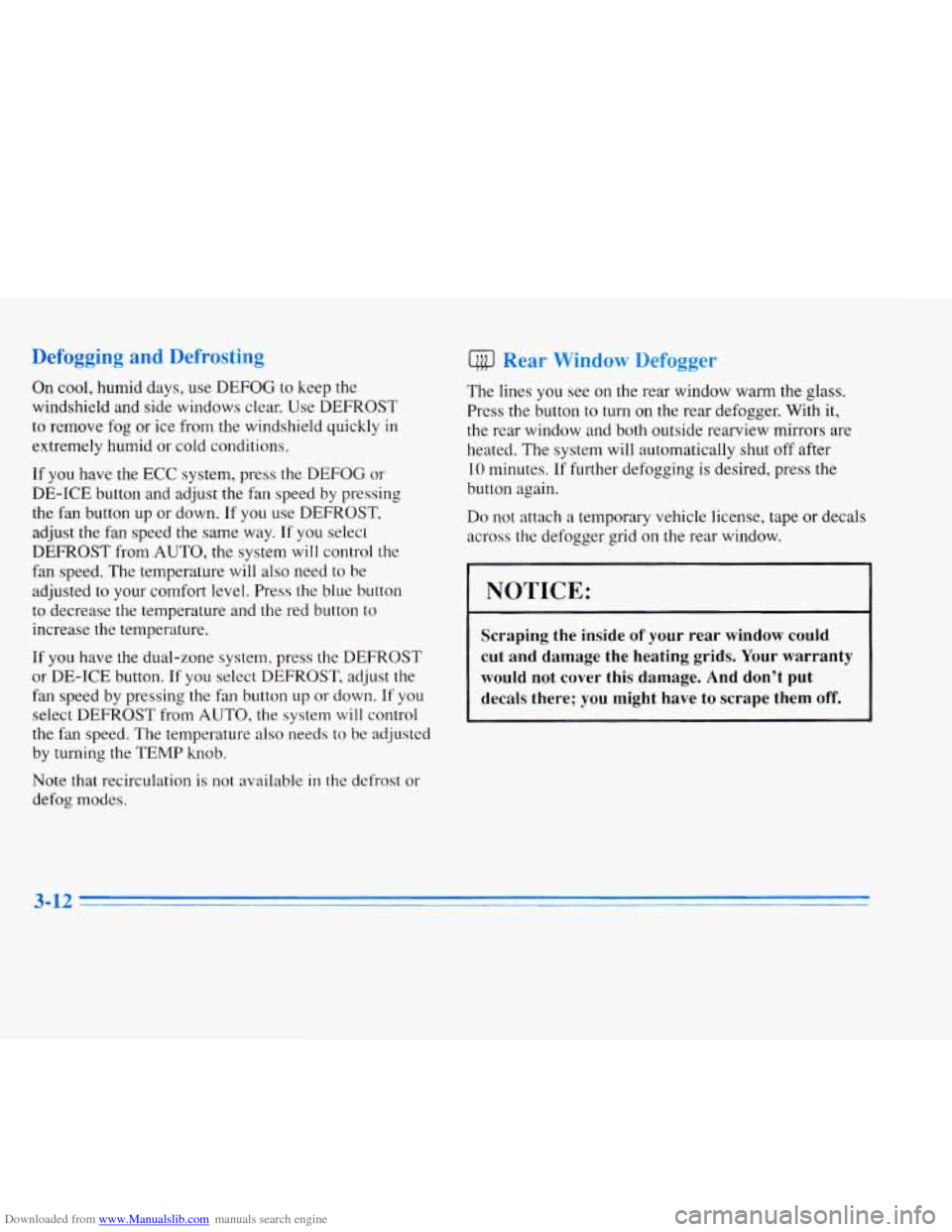
Downloaded from www.Manualslib.com manuals search engine Defogging and Defrosting
On cool, humid days, use DEFOG to keep the
windshield and side windows clear, Use DEFROST
to remove fog or ice from the windshield quickly in
extremely humid or cold conditions.
If you have the ECC system, press the DEFOG or
DE-ICE button and adjust the
fm speed by pressing
the fan button up or down.
If you use DEFROST,
adjust the fan speed the same way.
If you select
DEFROST from AUTO, the system will control the
fan speed.
The temperature will also need to be
adjusted to your comfort level. Press the blue button
to decrease the temperature and the red button to
increase the temperature.
If you have the dual-zone system, press the DEFROST
or
DE-ICE button. If you select DEFROST, adjust the
fan speed by pressing the fan button up or down.
If you
select
DEFROST from AUTO, the system will control
the fan speed. The temperature also needs
to be adjusted
by turning the
TEMP knob.
Note that recirculation is not available in the defrost or
defog modes.
@ Rear Window Defogger
The lines you see on the rear window warm the glass.
Press the button to turn on the rear defogger. With it,
the rear window and both outside rearview mirrors are heated. The system will automatically shut off after
10 minutes. If further defogging is desired, press the
button again.
Do not attach a temporary vehicle license, tape or decals
across the defogger grid on
the rear window.
I I
I NOTICE:
r
~~
Scraping the inside of your rear window could
cut and damage the heating grids. Your warranty
would not cover this damage. And don’t put
decals there;
you might have to scrape them off.
3-12
Page 205 of 354
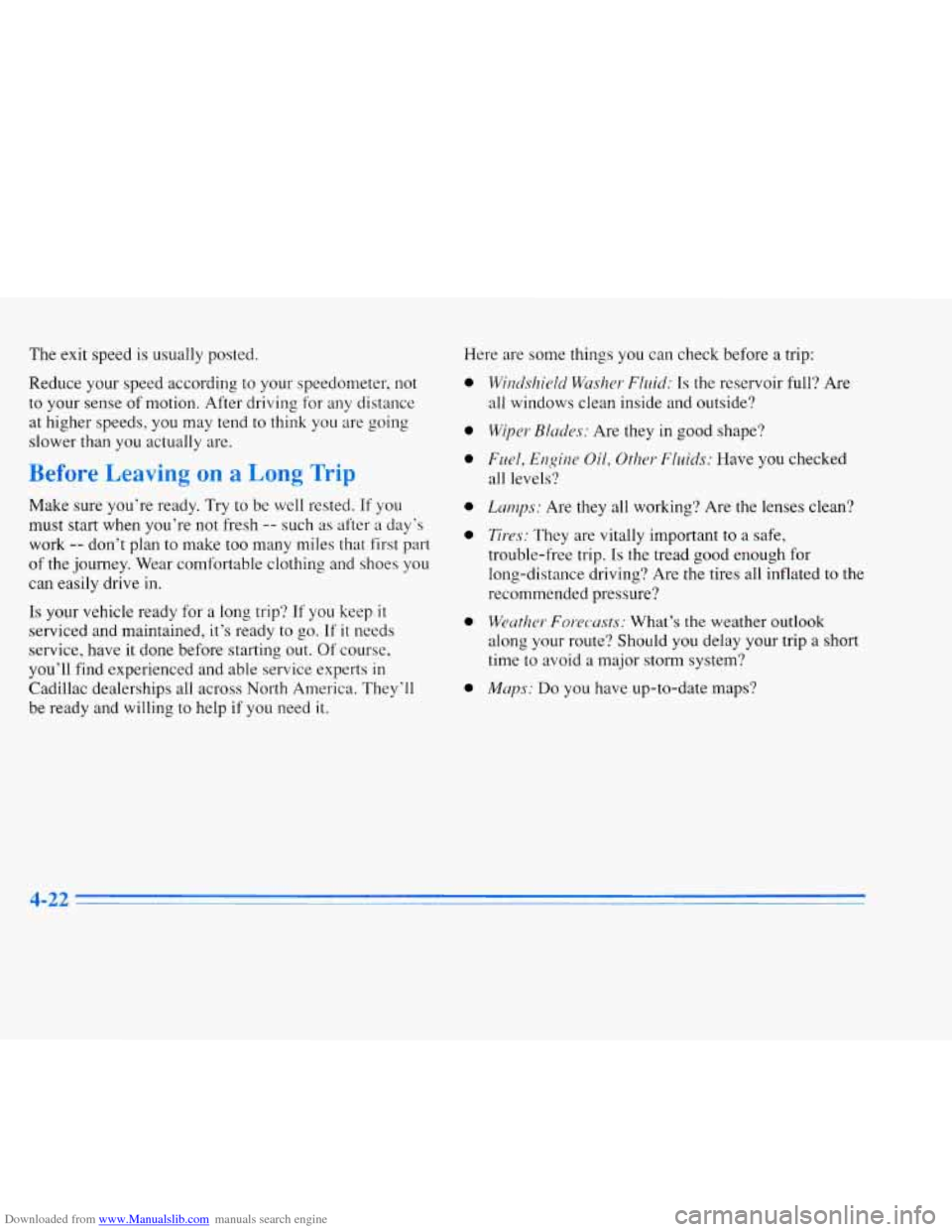
Downloaded from www.Manualslib.com manuals search engine The exit speed is usually posted.
Reduce your speed according to your speedomete.r, not
to your sense of motion. After driving for any distance
at higher speeds, you may te.nd to think you are going
slower than you actually are.
Before Leaving on a Long Trip
Make sure you’re ready. Try to be well rested. If you
must start when you’re not fresh
-- such as after a day’s
work
-- don’t plan to make too many miles that first part
of the journey. Wear comfortable clothing and shoes you
can easily drive in.
Is your vehicle ready for a long trip‘? If you keep it
serviced and maintained, it’s ready to go. If it needs
service, have it done before starting out. Of course,
you’ll find experienced and able service experts in
Cadillac dealerships all across North America. They’ll
be ready and willing to help if you need
it.
Here are some things you can check before a trip:
0
0
0
Wimid1icld Washer Fluid: Is the reservoir full? Are
all windows clean inside and outside?
Wiper Blndes: Are they in good shape?
Fuel, Eugilze Oil, Other- Fluids: Have you checked
all levels?
Lmps: Are they all working? Are the lenses clean?
Tiws: They are vitally important to a safe,
trouble-free trip.
Is the tread good enough for
long-distance driving? Are the tires all inflated to
the
recommended pressure?
Weatlzer Forecasts: What’s the weather outlook
along your route? Should you delay your trip a short
time
to avoid a major storm system?
Maps: Do you have up-to-date maps?
4-22
Page 211 of 354

Downloaded from www.Manualslib.com manuals search engine Tie a red cloth to your vehicle to alert police that
you’ve been stopped by the snow..
0 Put on extra clothing or wrap a blanket around you.
If you have no blankets or extra clothing, make body
insulators from newspapers, burlap bags, rags, floor
mats
-- anything you can wrap around yourself or
tuck under your clothing to keep warm.
You can run the engine to keep warm, but be careful. Snow
can trap exhaust gases under your vehicle.
This can cause deadly CO (carbon monoxide) gas
to get inside. CO could overcome you and kill
you.
You can’t see it or smell it, so you might not
know it is in your vehicle. Clear away snow from
around the base of your vehicle, especially any
that is blocking your exhaust pipe. And check
around again from time to time to be sure snow doesn’t collect there.
Open
a window just a little on the side of the
vehicle that’s
away from the wind. This will help
keep CO
out.
4-28
‘1
Page 212 of 354
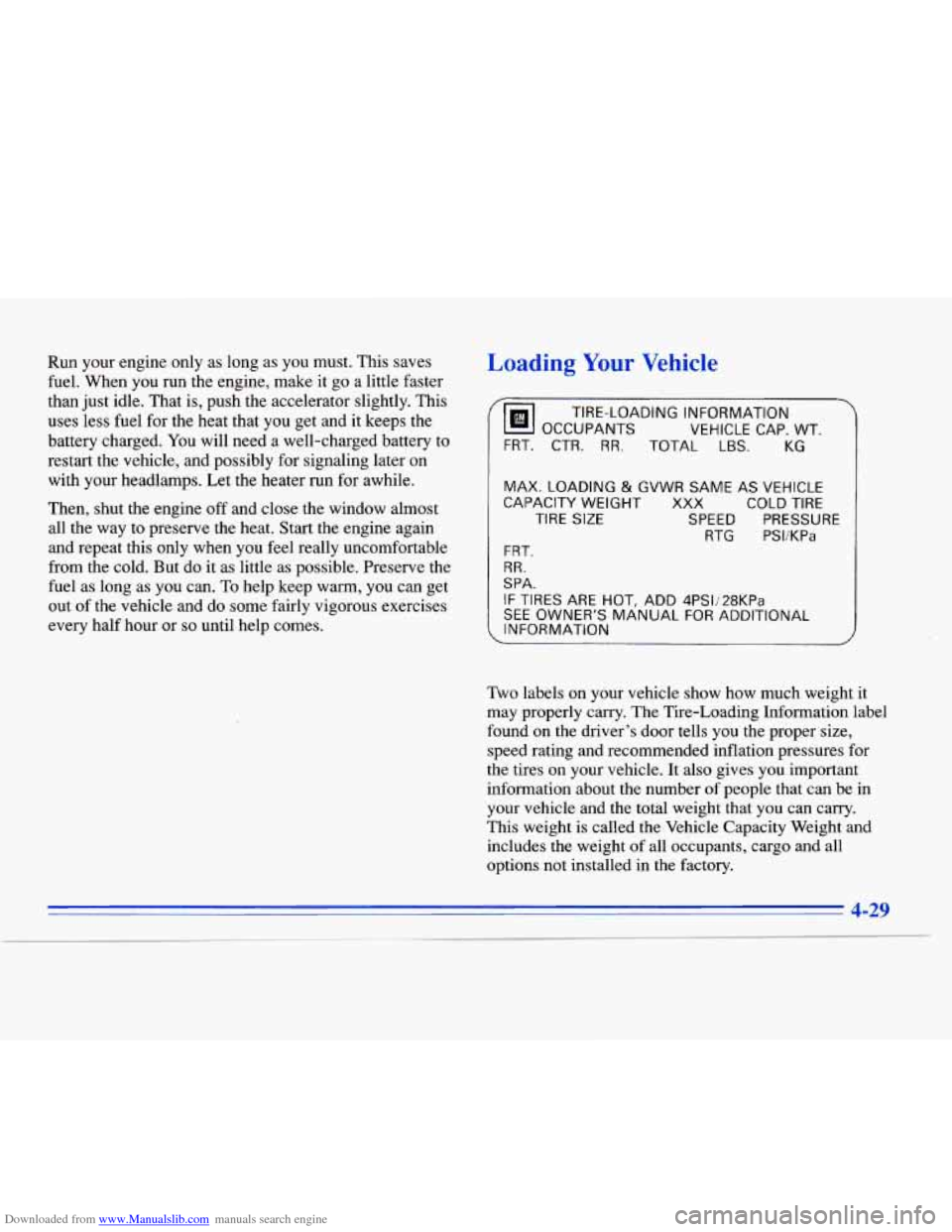
Downloaded from www.Manualslib.com manuals search engine Run your engine only as long as you must. This saves
fuel. When you run the engine, make it go a little faster
than just idle. That
is, push the accelerator slightly. This
uses less fuel for the heat that you get and it keeps the
battery charged. You will need a well-charged battery to
restart the vehicle, and possibly for signaling later on
with your headlamps. Let the heater run for awhile.
Then, shut the engine off and close the window almost
all the way to preserve the heat. Start the engine again
and repeat this only when you feel really uncomfortable
from the cold. But do it as little as possible. Preserve the
fuel as long
as you can. To help keep warm, you can get
out of the vehicle and do some fairly vigorous exercises
every half hour or
so until help comes.
Loading Your Vehicle
‘ OCCUPANTS
VEHICLE CAP. WT.
TIRE-LOADING INFORMATION
FRT. CTR.
RR. TOTAL LBS. KG
MAX. LOADING & GVWR SAME AS VEHICLE
CAPACITY WEIGHT
XXX COLD TIRE
TIRE SIZE SPEED PRESSURE
RTG PSI/KPa
FRT.
RR.
SPA.
IF TIRES ARE HOT. ADD 4PS1/28KPa
SEE OWNER’S MANUAL FOR ADDITIONAL
INFORMATION
Two labels on your vehicle show how much weight it
may properly carry. The Tire-Loading Information label
found on the driver’s door tells you the proper size,
speed rating and recommended inflation pressures for
the tires on your vehicle. It also gives you important
information about the number of people that can be in
your vehicle and the total weight that you can carry.
This weight is called the Vehicle Capacity Weight and
includes the weight of all occupants, cargo and all
options not installed in the factory.
I
4-29
Page 238 of 354
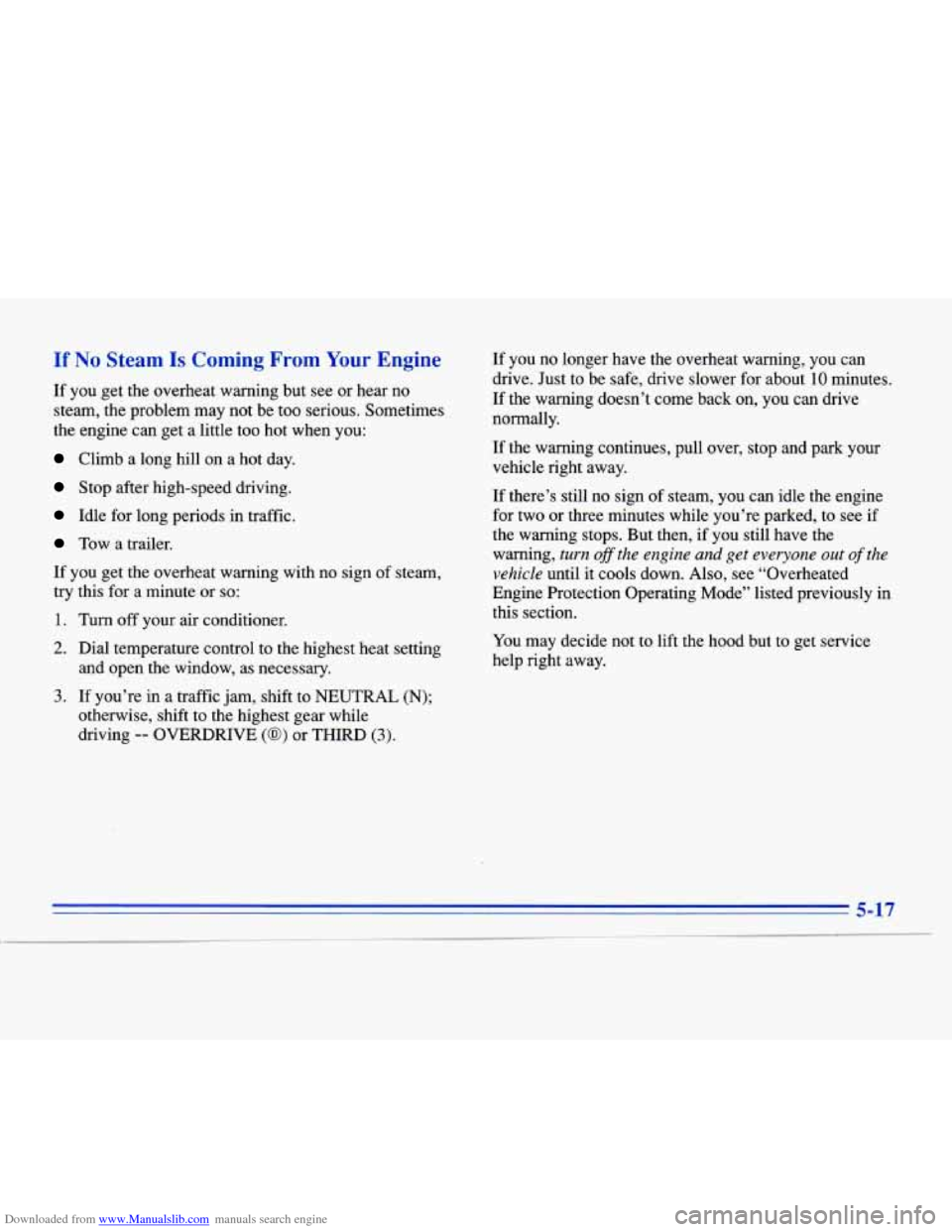
Downloaded from www.Manualslib.com manuals search engine If No Steam Is Coming From Your Engine
If you get the overheat warning but see or hear no
steam, the problem may not be too serious. Sometimes
the engine can get a little too hot when you:
Climb a long hill on a hot day.
Stop after high-speed driving.
Idle for long periods in traffic.
Tow a trailer.
If you get the overheat warning with no sign of steam,
try this for
a minute or so:
1. Turn off your air conditioner.
2. Dial temperature control to the highest heat setting
and open the window, as necessary. If you no longer have me overheat warning, you can
drive.
Just
to be safe, drive slower for about 10 minutes.
If the warning doesn’t come back on, you can drive
normally.
If the warning continues, pull over, stop and park your
vehicle right away.
If there’s still no sign of steam,
you can idle the engine
for
two or three minutes while you’re parked, to see if
the warning stops. But then,
if you still have the
warning,
turn ofthe engine and get everyone out of the
vehicle
until it cools down. Also, see “Overheated
Engine Protection Operating Mode” listed previously
in
this section.
You may decide not to lift the hood
but to get service
help right away.
3. If you’re in a traffic jam, shift to NEUTRAL (N);
otherwise, shift to the highest gear while
driving
-- OVERDRIVE (a) or THIRD (3).
5-17
1
Page 303 of 354
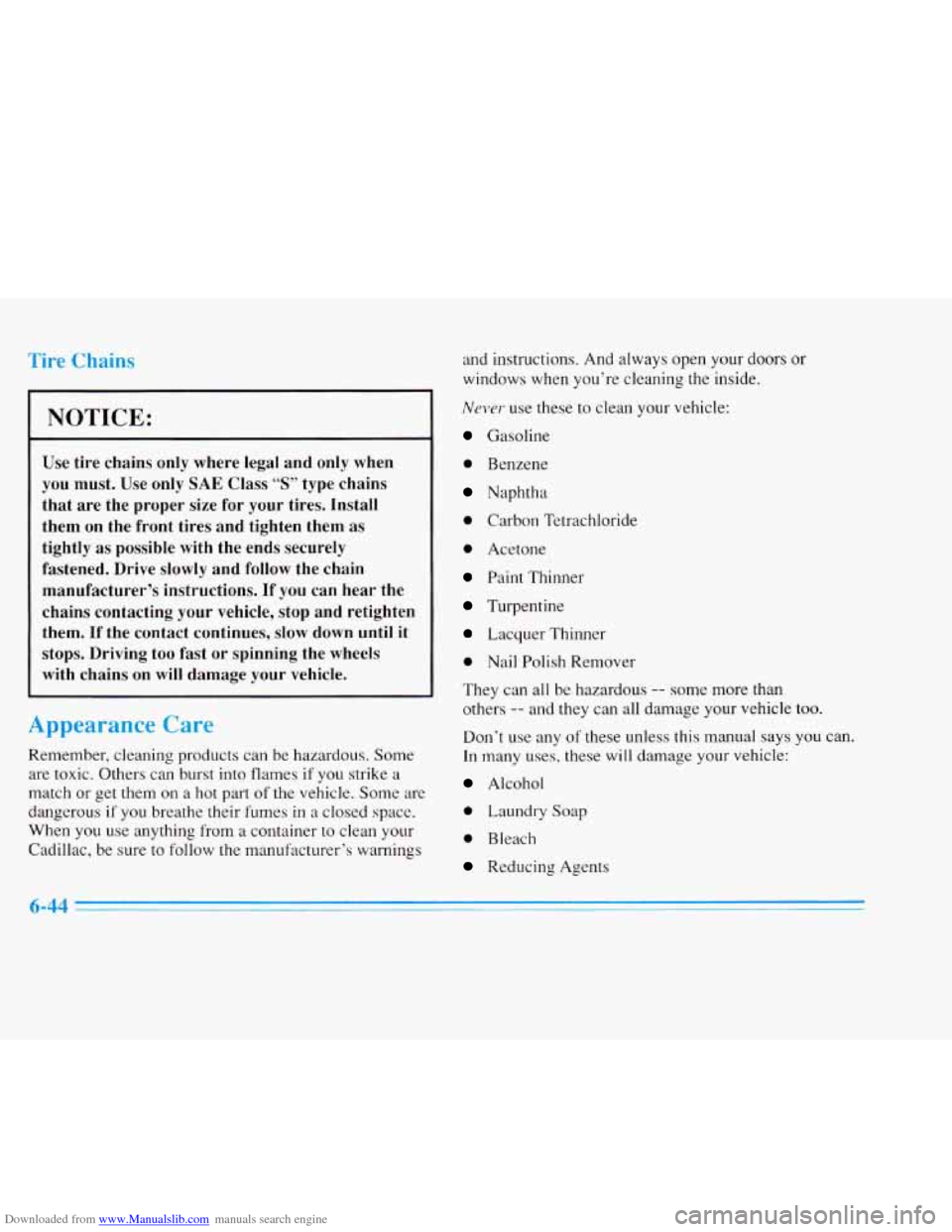
Downloaded from www.Manualslib.com manuals search engine Tire Chains
NOTICE:
Use tire chains only where legal and only when
you must. Use only
SAE Class “S” type chains
that are the proper size for your tires. Install
them on the front tires and tighten them
as
tightly as possible with the ends securely
fastened. Drive slowly and follow the chain
manufacturer’s instructions.
If you can hear the
chains contacting your vehicle, stop and retighten
them.
If the contact continues, slow down until it
stops. Driving too fast or spinning the wheels
with chains on will damage your vehicle.
Appearance Care
Remember, cleaning products can be hazardous. Some
are toxic. Others can burst into flames
if you strike a
match or get them on
a hot part of the vehicle. Some are
dangerous
if you breathe their fumes in a closed space.
When you use anything from
a container to clean your
Cadillac, be sure to follow
the manufxturer’s warnings and
instructions. And always open your doors
or
windows when you’re cleaning the inside.
Never use these to clean your vehicle:
Gasoline
0 Benzene
Naphtha
0 Carbon Tetrachloride
0 Acetone
Paint Thinner
Turpentine
Lacquer Thinner
0 Nail Polish Remover
They can
all be hazardous -- some more than
others
-- and they can all damage your vehicle too.
Don’t use any
of these unless this manual says you can.
In many uses, these will damage
your vehicle:
Alcohol
0 Laundry Soap
0 Bleach
Reducing Agents
6-44
Page 307 of 354
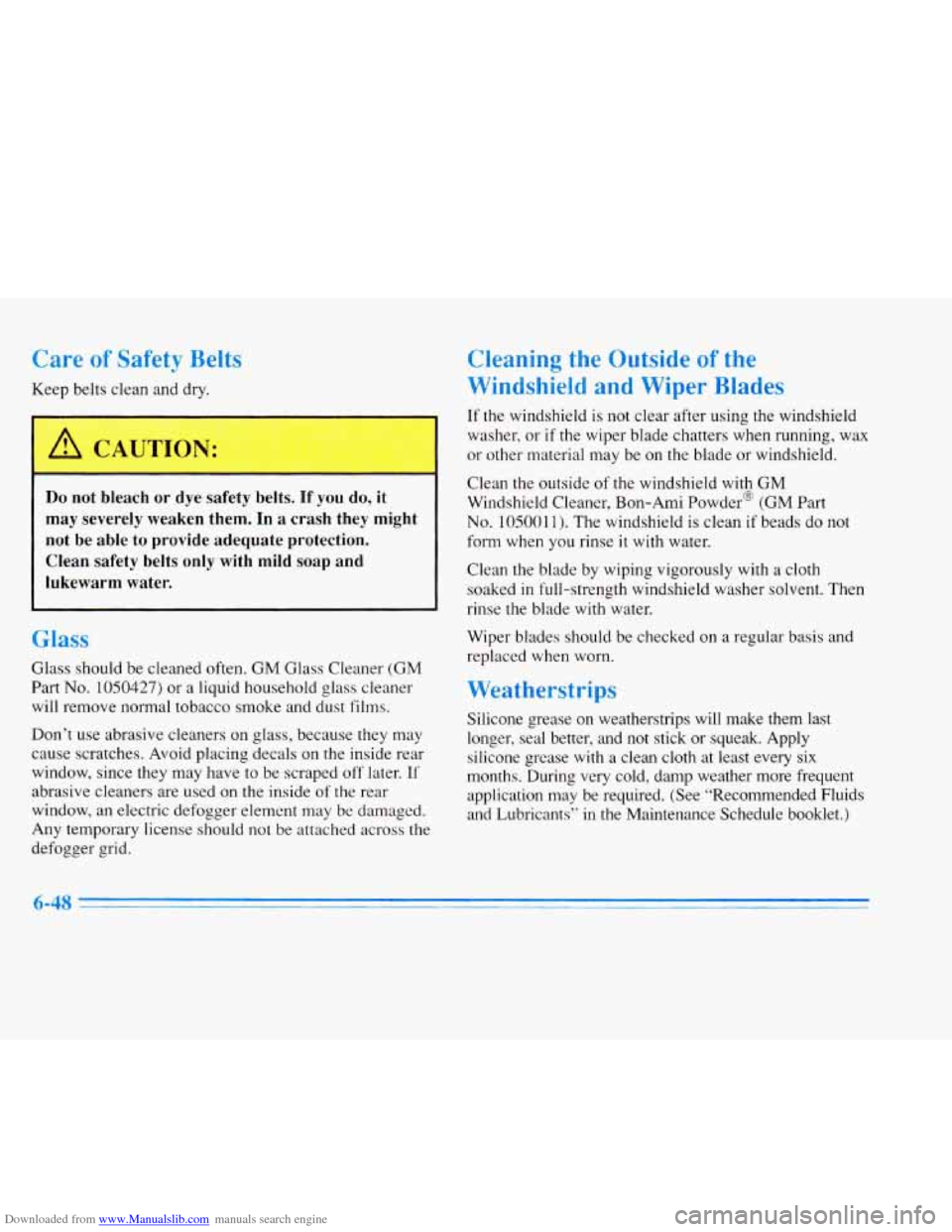
Downloaded from www.Manualslib.com manuals search engine Care af Safety Belts
Keep belts clean and dry.
A CAUTION:
Do not bleach or dye safety belts. If you do, it
may severely weaken them.
In a crash they might
not be able to provide adequate protection.
Clean safety belts only with mild
soap and
lukewarm water.
Glass
Glass should be cleaned often. GM Glass Cleaner (GM
Part No. 1050427) or a liquid household glass cleaner
will remove normal tobacco smoke and dust films.
Don’t use abrasive cleaners on glass, because they may
cause scratches. Avoid placing decals on the inside rear
window, since they may have to be scraped
off later. If
abrasive cleaners are used on the inside of the rear
window, an electric defogger element may be damaged.
Any temporary license should not be attached across the
defogger grid.
Cleaning the Outside of the
Windshield and Wiper Blades
If the windshield is not clear after using the windshield
washer, or
if the wiper blade chatters when running, wax
or other material may be on the blade or windshield.
Clean the outside of the windshield with
GM
Windshield Cleaner, Bon-Ami Powder@ (GM Part
No. 105001 1). The windshield is clean if beads do not
form when you rinse it with water.
Clean the blade by wiping vigorously with a cloth
soaked in full-strength windshield washer solvent. Then
rinse the blade
with water.
Wiper blades should be checked on a regular basis and
replaced when worn.
Weatherstrips
Silicone grease on weatherstrips will make them last
longer, seal better, and not stick or squeak. Apply
silicone grease
with a clean cloth at least every six
months. During very cold, damp weather more frequent
application may be required. (See “Recommended Fluids
and Lubricants’’
in the Maintenance Schedule booklet.)
6-48